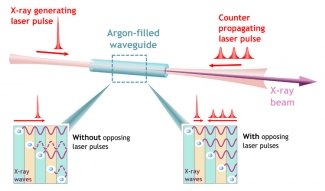It’s easy to make X-rays. Physicians and dentists make them routinely in their offices with a Roentgen X-ray tube, which emits X-rays every which way — just like a light bulb, which is nothing like a laser.
What’s hard is to make X-rays march in step in the same direction — in other words, act like a coherent beam of laser light. This year marks the 40th anniversary of the first reasonable proposal to build an X-ray laser, but scientists have found it challenging to translate this idea into a practical device. Because most of today’s X-ray lasers require so much power, they must rely on large fusion laser facilities, or even a nuclear weapon, to generate laserlike X-ray beams. Not surprisingly, very few fusion laser facilities have been built, and access to them is limited. Research physicists who require a low-power–optics-table-sized X-ray laser have been patiently waiting for decades.
The long wait for a reasonably sized X-ray laser could be drawing to a close, however, thanks to a clever new idea developed by graduate students Xiaoshi Zhang and Amy Lytle working with Fellows Margaret Murnane and Henry Kapteyn and Senior Research Associate Oren Cohen. “We’ve come up with a good end run around the requirement for a monstrous power source,” says Kapteyn.
The researchers use a powerful visible laser to pluck electrons from atoms of argon (Ar) inside a waveguide. Then, the electrons are slammed back into the same atoms (like boomerangs), generating X-rays in a directed, but weak, beam. The challenge is adding together the X-ray waves emitted from a large number of atoms to make a beam bright enough to be useful.
Unfortunately, the waves of X-rays don’t all come out marching in step (with their wave crests and troughs aligned) because the visible laser light and X-rays travel at different speeds through the Ar gas. This means that while some of the emitted X-ray waves add constructively and become stronger, X-ray waves from other regions add destructively and cancel out the net X-ray emission.
The researchers cleverly opt to cancel the X-ray emission from regions causing destructive interference. They accomplish this by sending weak pulses of laser light into the gas-filled waveguide from the opposite direction to the laser beam generating the X-rays. The laser beam traveling backwards through the gas forms a “crystal structure” made of light. This “light crystal” makes it possible to scramble the out-of-sync electrons plucked from atoms so that they slam back into the atoms at random times. In this way, the researchers are able to eliminate the X-ray waves that weaken the X-ray output anywhere that the crystal structure made from light is present.
With this ingenious trick, the researchers can intensify the strength of the laserlike X-ray beam by over a hundredfold at photon energies of around 70 eV. And, they do it on an ordinary optics bench without fusion power! Once they have strengthened the X-ray beam, they find that they can select exactly which X-ray energy to intensify. Then, they can manipulate the orbiting electrons in a time frame of a billionth of a billionth of a second — in effect controlling not only when an electron boomerang returns to an atom, but also which electron is manipulated.
Murnane says that, in theory, it should be possible to extend this technique all the way into the hard X-ray region of the electromagnetic spectrum. “This is a problem we’re itching to solve,” she says. Kapteyn adds, “If we can do this, it might make it possible to improve X-ray imaging resolution by a thousandfold, with impacts in medicine, biology, and nanotechnology.” - Julie Phillips




